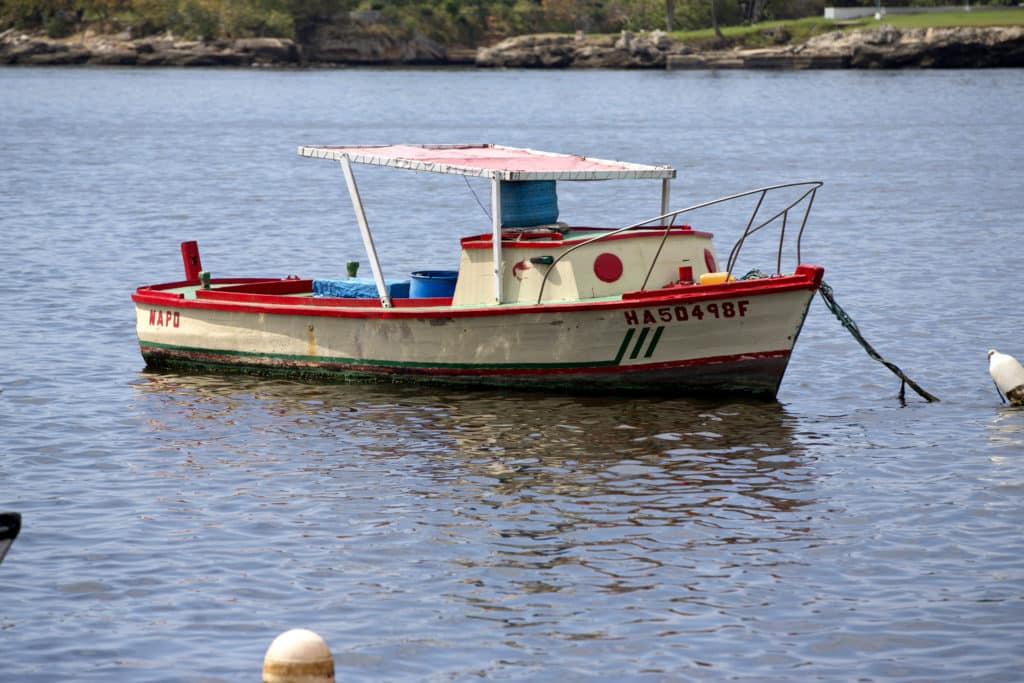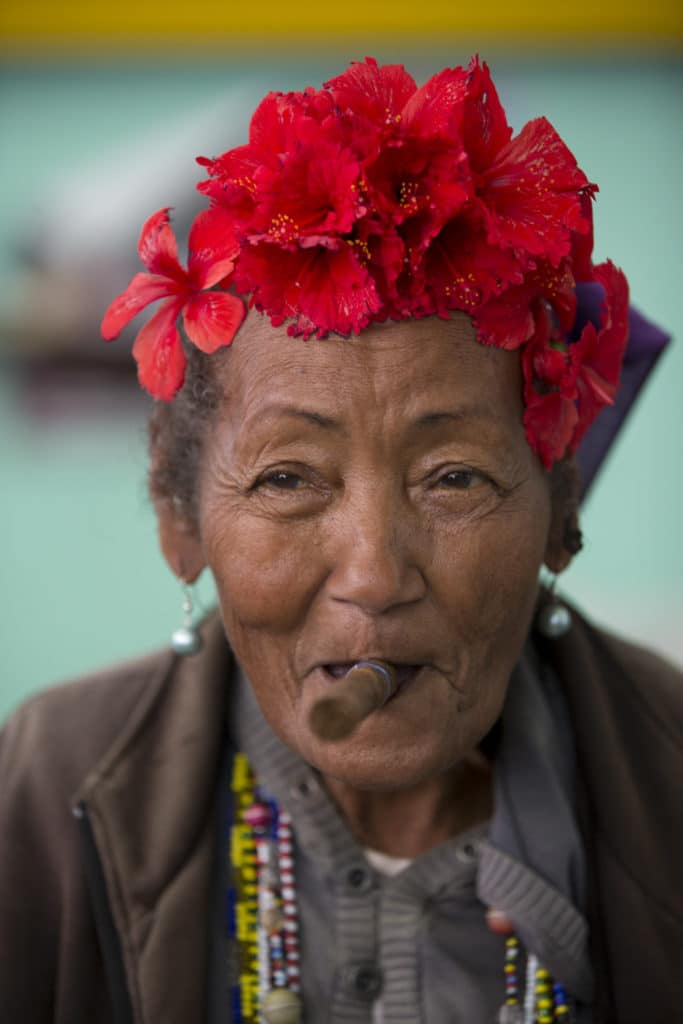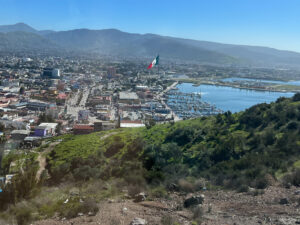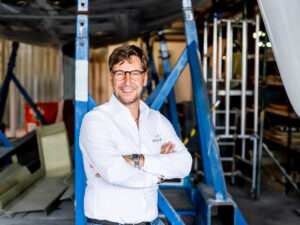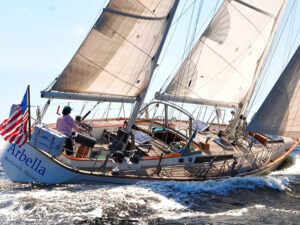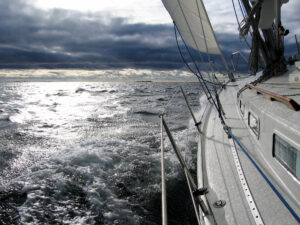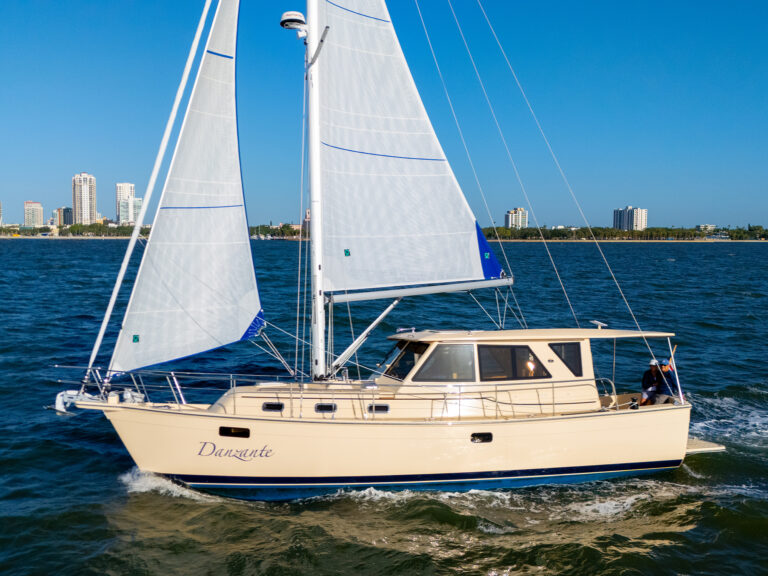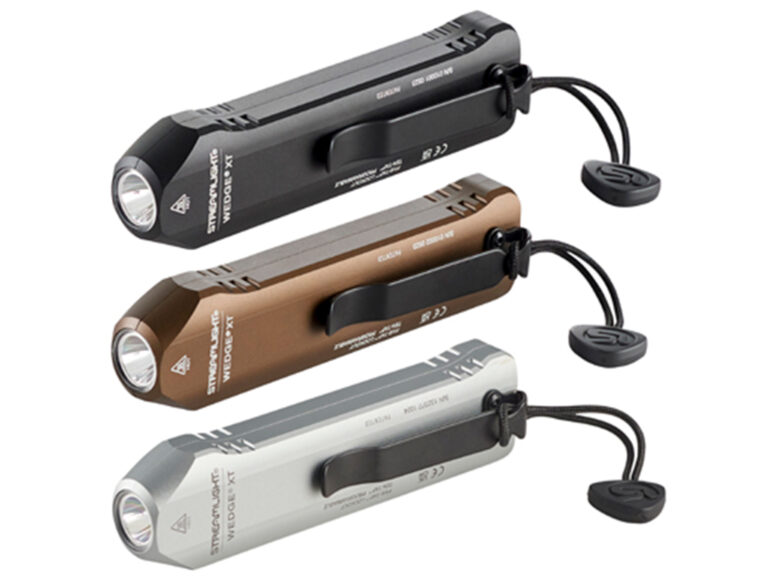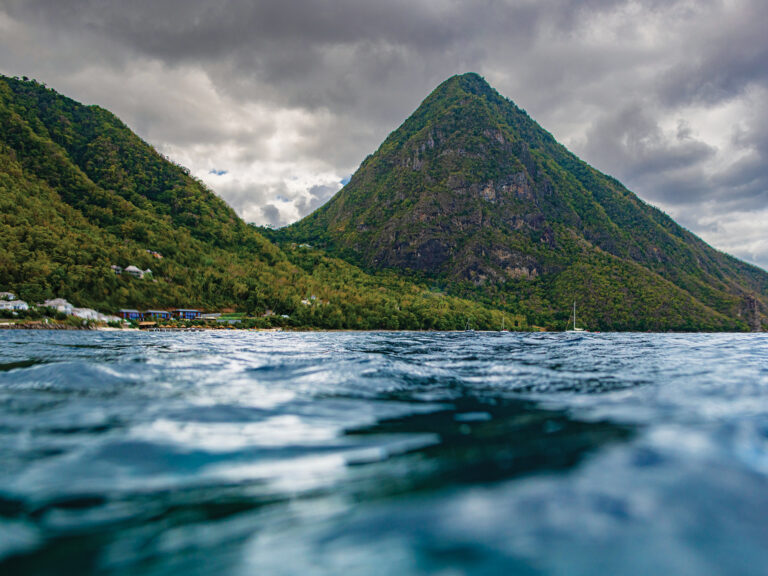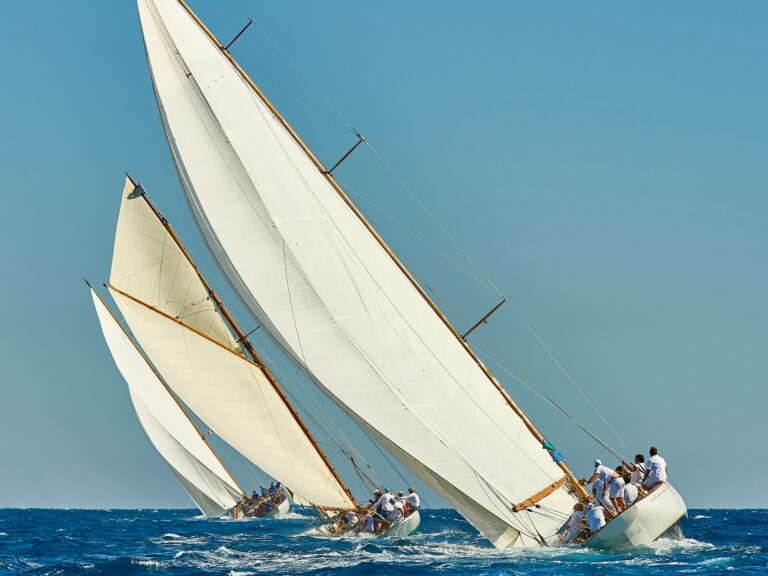I was on watch aboard the American-flagged 48-footer Consulting Time II as the coastal hills of northeastern Cuba slowly came into view. From 10 miles out, the shoreline looked steep and rugged. The smell of brush fires in the distance, perhaps in the sugar cane fields, added to the early morning haze. Now well inside the country’s territorial waters, which extend 12 nautical miles from the shore, we attempted to make initial contact with the Cuban Guardafronteras, or Coast Guard, but our calls went unanswered. We continued on toward the Puerto de Vita harbor entrance, which was clearly identifiable by a white light tower on the east side of the channel; it was well-marked and opened into a small bay, a perfect hurricane hole, just across from Marina Internacional Puerto de Vita, which operates as a joint venture between the Cuban government and the Gaviota Tourism Group. After successfully hailing the marina, we were told to anchor and await a visit from customs and immigration officials. Having lost our Q flag, we hoisted a yellow T-shirt.
One quickly learns patience in Cuba.
After anchoring at 0920, our first official contact was with a doctor, an epidemiologist, about two hours later. Cubans, we’d learn, are extremely polite, and he told us with apologies that he’d been delayed partly because he did not have a home or mobile phone. A kind man in an immaculate white lab coat, he inquired about our overall health and then, remarkably, took our temperatures.
It was just the first of many surprises.
Roughly two years earlier, Doug Diehl first began serious planning for a trip to Cuba aboard Consulting Time II, his Morris 486 Ocean Series sailboat. With almost 40,000 nautical miles of blue water under its keel since its 2004 launching, the Chuck Paine-designed sloop seemed to be constantly on the move, having already recorded a transatlantic voyage and extensive cruising in the Caribbean and the Med. But to Diehl, the island of Cuba always loomed large, even if it was forbidden fruit. Despite his plans and wishes, given the U.S.-imposed travel restrictions on American recreational vessels, the possibility of actually, legally visiting Cuba remained elusive. In December 2014, as President Obama moved to re-establish full diplomatic relations and ease the embargo against visiting Cuba, that began to change. Diehl’s two-year-old float plan was quickly dusted off. We would travel under a so-called “general license,” granting me permission to travel as a journalist and my crewmates, both environmental professionals, to visit while conducting water-quality research. (That said, though our application was in, when we set sail we did not have in our possession a U.S. Commerce Department export certificate for the vessel.)
I joined Diehl and his longtime sailing partner, Kent Patterson, on the Bahamian island of Great Exuma, our point of departure on April 25, following the annual National Family Island Regatta. The original plan called for four, but our other crewmember had to cancel at the eleventh hour. Fortunately Diehl, Patterson and I had all sailed together on bluewater passages and worked well as a three-man crew. We covered the roughly 250 nautical miles to Cuba in about a day and a half. Following our initial medical examination, the other officials arrived at about 2 p.m., replete with crisp uniforms and a drug-sniffing Brittany spaniel. Once the pooch established that we were free of contraband, he napped while the officers shuffled papers. They then instructed us to proceed to the marina and Med moor. To their embarrassment, the ancient Mercury on their skiff failed to start, and we towed them in. I wished that I had spent as much time learning Cuban slang as I had studying the history of the Cuban Revolution, so I could understand their choice words for that outboard.
Once moored, the entry process continued, followed by a check-in at the marina office. Ah, patience. Still, despite the heat and delays, our first Cuban encounters were filled with humorous Spanglish banter. The entire experience couldn’t have been more pleasant.
The marina itself was well-maintained and hosted just a handful of boats, including a large party catamaran for entertaining guests from a nearby resort. It also had an outdoor restaurant and bar, and a small shop that sold beer, rum and cigars, but it was certainly not a place to provision.
We were anxious to travel inland and see a bit more of the region, and the marina manager arranged for us to hire a taxi and driver so that we could visit the provincial capital of Holguín, about 40 miles to the south. The driver, Victor, was a big guy in his 20s, a true entrepreneur. His ride was a 1999 Russian Lada complete with headrest-mounted DVD players blasting Cuban music videos. Passing horse-drawn carts, bicycles, vintage autos and Soviet-era farm trucks in a swirl of dust and diesel smoke, Victor drove with the skill of a New York cabbie.
Thanks to Victor’s contacts, in Holguín we converted some cash to Cuban dollars (or CUCs, the tourist currency) and explored the town. Dining choices were limited, but a Dutch sailor at the marina had recommended a paladar, a privately owned restaurant, for dinner. The fare was outstanding and modestly priced by U.S. standards, but quite expensive for Cubans. By comparison, we visited a state-run ice cream parlor for dessert, waiting in line with the locals for a free table and one scoop of the day’s only flavor, vanilla. Unlike the restaurant, the ice cream parlor did not accept CUCs. Fortunately we were seated with a cubano who, with a smile, graciously picked up our tab of 2.4 pesos (about 10 cents) in exchange for a ball cap and a handshake.
We soon discovered that Holguín, like most of Cuba, is worn and tired. The infrastructure and the people have endured and survived 60 years of U.S. embargo, but both are weary. Still, the spirit of the Cuban people remains positive, especially now, given the possibility of normal diplomatic relations with their Yankee neighbors. My sense is that they clearly want to improve their standard of living, but not at the expense of years of sacrifice to build what appears to be a functioning socialist society, one where education, literacy and health care are more important than the countless useless products offered by our big-box stores. Yes, they are poor, but not hungry or unread.
Our second day ashore took us to nearby Rafael Freyre, aka Santa Lucía, an old central, or sugar mill. At the bank there we obtained some Cuban pesos, the local currency. We waited in line with campesinos (farmers), housewives and office workers to convert our funds from euros to buy provisions for our sail to Havana. Again, patience is a virtue quickly learned from the Cuban people. Waiting in line for anything is turned into an opportunity to visit with neighbors and friends. We left with a stack of pesos as well as three pineapples, a bunch of tomatoes and a few yams from a street vendor, all of which cost less than the equivalent of $2. We also grabbed some fresh bread from a state-run bakery (which cost about a quarter), and a couple of bottles of rum.
Returning to the marina, we readied the boat for sea and obtained our travel papers, including the Certificado de Despacho Internacional. The critical despacho permits a vessel to depart to another port, in our case Havana, 412 nautical miles to the west.
Two and a half days later, shortly after sunrise, Havana’s eastern beaches came into sight on May Day, a national holiday when Cubans reaffirm their support for the revolution and its leaders. With an overcast sky and light rain falling, we sailed just a couple of miles offshore. From what we’d seen, most of the island’s northern shoreline was free of any off-lying hazards to navigation. Unlike our first landfall, there were no steep mountains, and the coastline appeared to be built up with Soviet-era housing blocks that came right down to the sea and clearly had seen better days.
El Morro Castle, at the entrance to Havana, finally heaved into view, as did the city skyline and the famous Malecón seawall. Approaching the sea buoy at the mouth of the harbor, we were told via VHF radio by Havana’s port authorities to remain at least 5 nautical miles offshore as we made our way to Marina Hemingway, whose entrance lay about 10 nautical miles west of the city.
After a brief silence, my plea to the authorities to allow me to take a few photos was met with “OK, but do not enter Havana Harbor.” Meanwhile a Cuban government vessel stood sentry to our north.
To port, Havana was ablaze in the morning sun, with the Hotel Nacional’s twin towers glowing against a dark southern sky. Along the Malecón, a forest of Cuban flags flew in anticipation of the May Day parade. An hour or so later, we reached the red-and-white approach buoy that marked the entrance of the channel into the marina. The approach was straightforward and the channel well-marked, but our Navionics software was definitely off, placing our course outside of the channel and on the rocks.
Once safely in the marina, we headed to the Guardafronteras headquarters for entry formalities. As in Puerto de Vita, the officials were friendly and good-natured, despite having to work on a national holiday. After clearing in, we navigated the marina’s canals, tied up, and were met by the dockmaster and a utility worker, who helped with our lines and made sure that the power and freshwater service were working properly.
I was pleasantly surprised to find the marina so well maintained. I had expected much less in the way of facilities, which included a pool, several bars, a grocery, a motel, postal services and more. It is also home to the Hemingway Yacht Club, or Club Náutico, Cuba’s only yacht club. The marina was secured, but in no way were the guards overbearing. This same attitude prevailed among the police and military personnel we encountered. For example, I mistakenly carried our satellite phone ashore on a visit to the yacht club office. It was spotted by a security guard who promptly reported it to customs officers and the Guardafronteras. They appeared out of nowhere and very politely explained my transgression before escorting me back to the boat to leave it aboard. (They also took note of the incident and made sure we had it with us when we left.)
In Havana, through the friend of a stateside friend, we connected with a gentleman named Dionisio Arranz, or Dioni, who came highly recommended as a guide to the city. I had emailed him prior to our trip and told him our approximate arrival date, but once in Havana I found that it was impossible to call Cuba via our Iridium sat phone. Our cellphones were also useless. At the yacht club, however, a member loaned us his phone, and we finally contacted and met our soon-to-be-dear friend. Dioni was a dapper former government foreign-trade economist, in his late 70s or early 80s. His English was flawless. Dioni’s fee was $100 per day, and he arranged for a car and driver for an additional $30. As we discussed our itinerary, it was clear that nothing was off the table. We would see Cuba from a Cuban’s perspective; everything, from politics to religion to baseball, was open for discussion.
With plans to meet the next day, Dioni departed, and we enjoyed the hospitality of the marina and yacht club, which was hosting a holiday pig roast in honor of May Day. Among the guests were a smattering of European sailors and, of course, the Cuban members of the club, but we were the only Americans. Dinner was outstanding; a local busker working the tables for tips provided the music. He was kind enough to play a favorite of mine called “Hasta Siempre,” an emotional tribute to Che Guevara, to which all the Cubans joined in.
Dioni met us the next morning and we set off in yet another vintage Lada for the barrios of Havana. The city, in a word, was bustling. Cars, buses, trucks, horse-drawn carts — every conceivable form of transportation carried workers and students returning from the long holiday weekend. We did our laundry and visited a bank to exchange money; thanks to a contact of Dioni’s, we made it to the head of the line in short order. Afterward, we toured the city, enjoying a taste of everyday life. Havana is also worn, but exudes a special charm. In many ways, time appears to have stopped there. The architecture is stunning but, due to a lack of funding, in disrepair. That said, the city has been designated a UNESCO World Heritage Site and is slowly being restored, building by building, with a focus on the Old Havana tourist district.
Despite their age, most cars run, but at least at street level, the world of technology hasn’t advanced beyond CRT computer monitors and rotary dial phones. Still, people we observed seemed very content and proud of their country, particularly its historical struggles against imperialism. They certainly bear no malice toward Americans, whom they hold in high regard (well, except for some of our former leaders and their policies, which is another story).
The lack of crime and the absence of illegal drugs were striking; prison sentences are stiff. Political dissidence is tolerated unless, of course, it undermines the revolutionary government. Judging by the number of churches with welcoming open doors, the freedom of religion is alive and well.
Homelessness, Dioni told us, is also rare, thanks to government programs and a family-oriented culture where kinfolk and neighbors look out for one another. Wandering through many of the narrow streets, where the doors of small apartments were open to the sidewalk, you could smell dinner on the stove, hear a ball game on television, or catch the watchful eye of an abuela, or grandmother, gazing at you from her sitting room chair with a Mona Lisa smile.
For the next few days we roamed the city with Dioni, visited the agromercados, as the farmers markets are called, ate with locals and tourists, and immersed ourselves in a culture the likes of which none of us had ever experienced, either in the Caribbean or elsewhere.
Our planned departure date was quickly approaching, but I still did not have a photo of our boat sailing in front of El Morro at the entrance to Havana’s commercial harbor. Once in Cuba I discovered that this was not as simple as sailing back to Havana and taking the shot from a chase boat. In conversations with José Miguel Diaz Escrich, commodore of Club Náutico, I learned that permission to enter the harbor needed to come from the captain of the port, and that this was something that could take some time to accomplish. We needed to depart within 48 hours, and it now seemed impossible. Moreover, there were no chase boats available, and we would need to clear and re-enter the country if I were to be picked up after taking the shot from the shore. All of this was complicated and ultimately relied on permission being granted. Considering the timing and other variables, like weather, it was a long shot.
The commodore rose to the occasion and told me that he would personally plead for permission on my behalf. Twenty-four hours later, we were given the OK thanks to the commodore’s intervention.
The plan now called for our boat to clear the country at Marina Hemingway with just two aboard, then head east to Havana. I would stay in country, legally, and take a taxi to Havana to shoot the boat from the shore at the harbor entrance. I would then return to the marina via taxi, where I would meet the boat. My mates would re-enter, and then we’d depart for the U.S. with our crew intact. Complicated and inconvenient, but everyone involved, from the commodore to the Guardafronteras and marina security, was eager to make it happen — and it did. Thanks to all involved, we photographed Consulting Time II in front of El Morro, and while it might not rank as one of marine photography’s more powerful images, for me the back story will always be special. It may seem trivial, but together with our Cuban friends, we were able to make something happen that was deemed a bureaucratic impossibility. For me it has become a bit of a metaphor for what I hope will be continued cooperation between our two countries.
As we departed Marina Hemingway for Charleston, South Carolina, in a stiff early evening breeze, it became clear to me that Cuba is a very special place whose riches lie in its people — with their great integrity, kindness and a spirit of cooperation.
I am grateful to all of them. This forbidden fruit, which lies so close to our shore, is the sweetest I have ever tasted. I hope that now, after 60 years of isolation, it will be something that we can all share. In the meantime, I’ll need to muster some of that Cuban patience until I can visit again.
Based in midcoast Maine, John Snyder is an experienced offshore sailor and multimedia marine journalist who contributes regularly to yachting, business and travel publications. For more, visit his website marinemedia.biz.
If You go to Cuba

U.S. law regarding travel to Cuba is in flux. An excellent place to begin research into restrictions is the U.S. Department of the Treasury “Cuba Sanctions” web page, found by entering that search term at treasury.gov. The website offers links to many frequently asked questions and is regularly updated. There is also a link where you can sign up for email updates on the sanctions. Regulations can also be found in the U.S. Code of Federal Regulations, 31 CFR Part 515, Cuban Assets Control Regulations.
We made our trip “almost” legally. Although we were traveling under President Obama’s new general license, under which there are 12 permitted categories for visitors (see 31 CFR Part 515), travel to Cuba by boat requires a U.S. Department of Commerce export permit for a “temporary sojourn.” We applied for this document before leaving but did not have it in our possession upon departure. We also went uninsured, since U.S. insurance companies and brokers were unwilling to insure vessels while in Cuban waters. The export permit requirement was imposed by President George W. Bush in February 2004 (Presidential Proclamation No. 7757) to discourage U.S. recreational vessels from visiting Cuba.
Our cruising in Cuba was limited to our passage from Puerto de Vita to Havana. We relied on A Cruising Guide to Cuba, first edition, by Amaia Agirre and Frank Virgintino, which is available for free download online (freecruisingguides.com/cuba). Other cruising guides include Yacht Pilot’s Cruising Guide to Cuba, by Cheryl Barr (Volume 1, 2013; Volume 2 is soon to be released), and Cuba: A Cruising Guide, by Nigel Calder (1999).
Dionisio Arranz, our guide in Havana, makes it his business to guide anyone with a desire to experience Cuban culture. While he is not your typical see-the-historic-sights tour guide, he will tailor his services to whatever your needs might be. You can call him by cell (05-264-8500) or home phone (05-206-1111), reach him by fax (05-206-9642), or email him at [email protected].
U.S. dollars cannot be used in Cuba, nor can credit cards issued by U.S. banks. Dollars can be converted to Cuban convertible pesos (CUCs, the tourist currency) or Cuban pesos at banks, but a tax is added by the Cuban government. The best bet is to bring euros or another foreign currency for exchanges. Everyone wants CUCs because they are roughly on par with the U.S. dollar, but many local establishments take only pesos, which will dramatically discount some purchases.
The Cuban culture is marked by respectfulness and honesty, but while traveling, beware of hawkers selling cheap cigars as the more valuable Cohibas, and be sure to negotiate a taxi fee before you get in. You will also find street urchins who will hit you up for a few pesos — just say no. No one’s feelings get hurt.
A far as language, Spanish is the tongue of choice. Try learning a bit before you go — you’ll make lots of friends. Last but not least, brush up on the latest baseball news.
